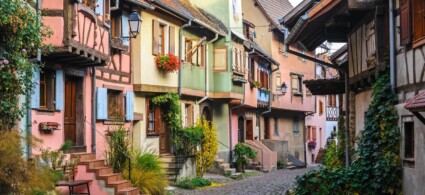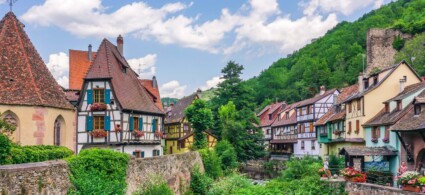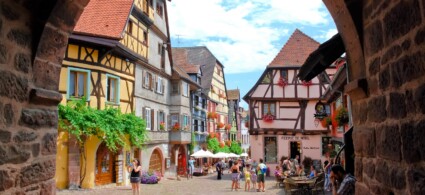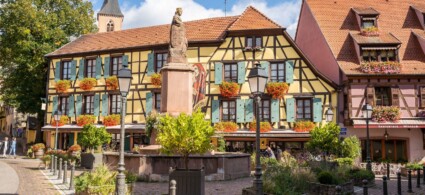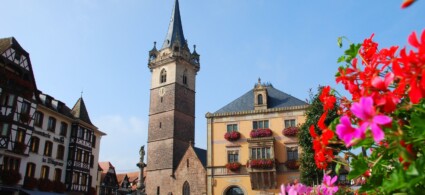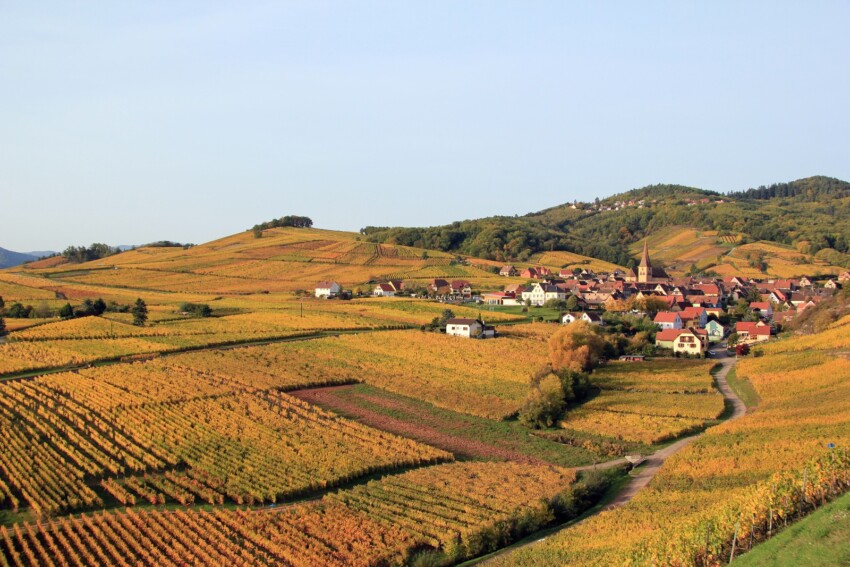

The Wine Route is certainly one of Alsace’s most evocative itineraries: 120 kilometres from north to south through a magnificent countryside carpeted in vines, dotted with perched castles and colourful villages with half-timbered houses that seem straight out of a fairy tale.
Although it is much exploited for tourism and commercial purposes, it represents a truly original way to discover Alsace, combining the exploration of the most picturesque towns with a visit to a few caves, the wineries that produce the famous Alsatian wines: Riesling, Pinot Blanc and Gewürztraminer.
The best way to explore the Wine Route is by car. In this way, you can enter the magnificent hilly landscape, avoid the motorway, stop at leisure at the most attractive spots, and visit the many attractions along the way: medieval Alsatian villages, fortified castles, Romanesque and Gothic churches.
Hiking enthusiasts can also follow the wine trails, on foot or by bicycle, to immerse themselves in nature and take wonderful bucolic walks.
Below are all the most important villages, following a hypothetical route from north to south.
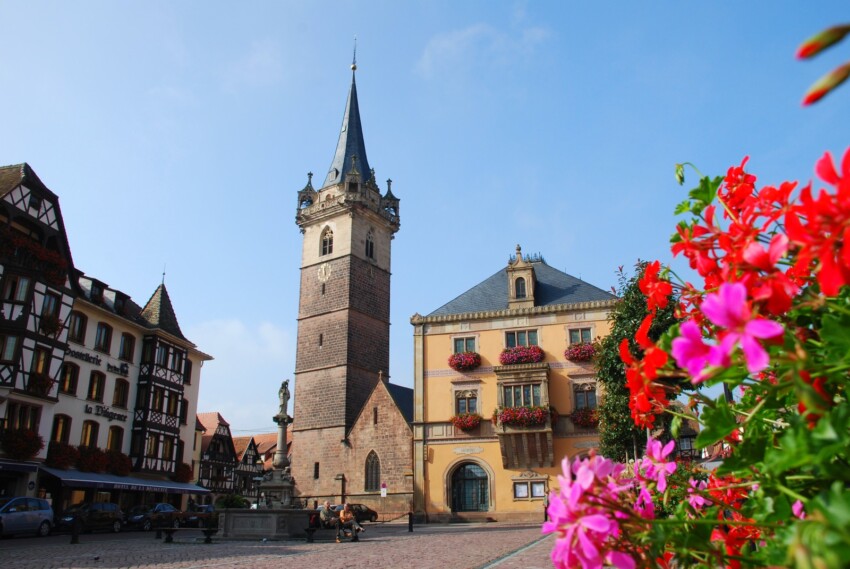
The proud town of Obernai is located at the crossroads of the three major areas of Alsace: the vineyards with the wine route, the Vosges and the large rural plain that begins just outside the town. Situated 25 km south-west of Strasbourg, Obernai is a picturesque fortified town around the Market Square, where a colourful market still takes place on Thursday mornings.
The square is adorned with old historical buildings and is the starting point for a short tour around the pedestrian streets full of shops, hidden courtyards and flower-filled alleys: don’t miss a trip to the tiny Canal de l’Ehn and the old synagogue, as well as ruelle de Juifs and the 13th-century ramparts.
Wine lovers can follow the Sentier Viticole du Schenkenberg, a 1.5-kilometre route through the vineyards to the cellars of local winegrowers.
This small Alsace village is literally surrounded by Sylvaner vineyards: a veritable explosion of colour and charm enriched by the blossoming of wild tulips!
Don’t miss a stroll through the old alleyways lined with charming beige, mauve and terracotta-coloured houses, a magnificent palette that matches the green of the vineyards.
To admire all its splendour, we recommend you take the sentier viticole that follows the fragrant hills to the towers of the Chateau du Haut Andlau, or hire bicycles for a rejuvenating ride through the vineyards.
Like the other picturesque villages in this area, Dambach-la-Ville is surrounded by vineyards and is full of wine cellars to be discovered, where you can sample the local wines.
It also boasts magnificent 14th-century ramparts made of pink granite and four gates topped by watchtowers: here you can fully breathe in the old Alsatian charm, thanks also to the picturesque half-timbered houses dating back to the Middle Ages.
Don’t miss a hike along the vineyards admiring the granite hills: the Sentier Viticole du Frankstein winds its way through nature and passes the lovely Chapelle Saint-Sebastien.
Selestat is the largest town in the area, famous above all for a large Bibliothèque Humaniste, which houses historical volumes of great value.
A stroll through the heart of the old town, full of half-timbered houses and shops embellished with trompe-l’oeil details, is not to be missed. Also interesting is a visit to theEglise Saint-Georges, one of the most charming Gothic churches in the region.
On Tuesday mornings, don’t forget to take a stroll around the colourful open-air market around the Eglise Saint-Foy.
This enchanting fortified town has grown larger than the other villages along the Wine Route, but retains its charm with its pastel-coloured half-timbered houses overflowing with geraniums.
You can discover its picturesque sides by following the ramparts along the Remparts XIVème Siecle, a 2 km path around the walls, or by admiring the Gothic-style medieval gates such as the Porte Haute.
A curiosity: a black page of the Inquisition was written in this town. Thirty-five women accused of witchcraft were burnt at the stake. To learn more about witch hunts in this area, you can visit the Maison des Sorcières.
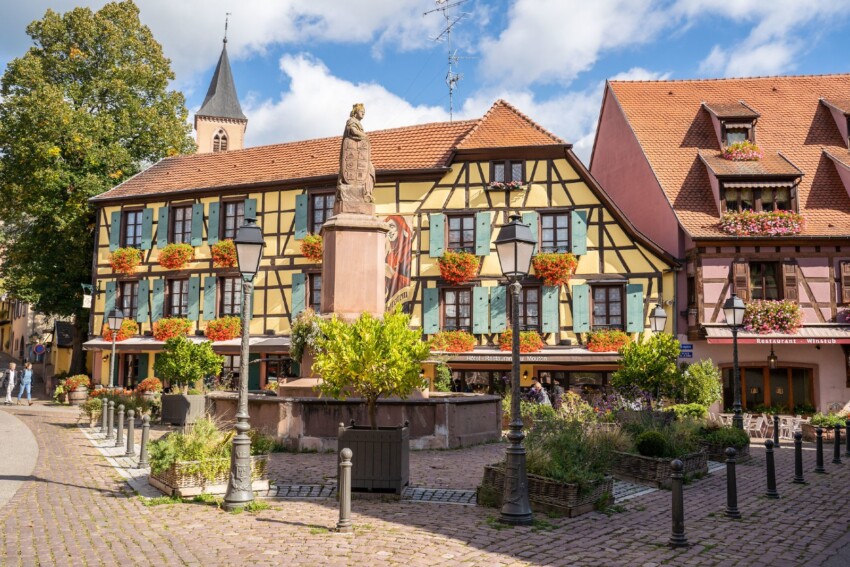
Ribeauvillé is undoubtedly a picture-postcard village and represents the quintessence of Alsace: narrow cobbled alleyways, charming pastel-coloured half-timbered houses covered in flowering vases, an exquisitely intact medieval atmosphere.
Nestling in a bucolic valley, the village will enchant you with its picturesque streets and countless photo opportunities that seem to have leapt straight out of a Brothers Grimm fairy tale.
Don’t miss the sight of the three castles that dominate the village, Saint-Ulrich, Giersberg and Haut Ribeaupierre, which can also be reached on foot via a path through the vineyards.
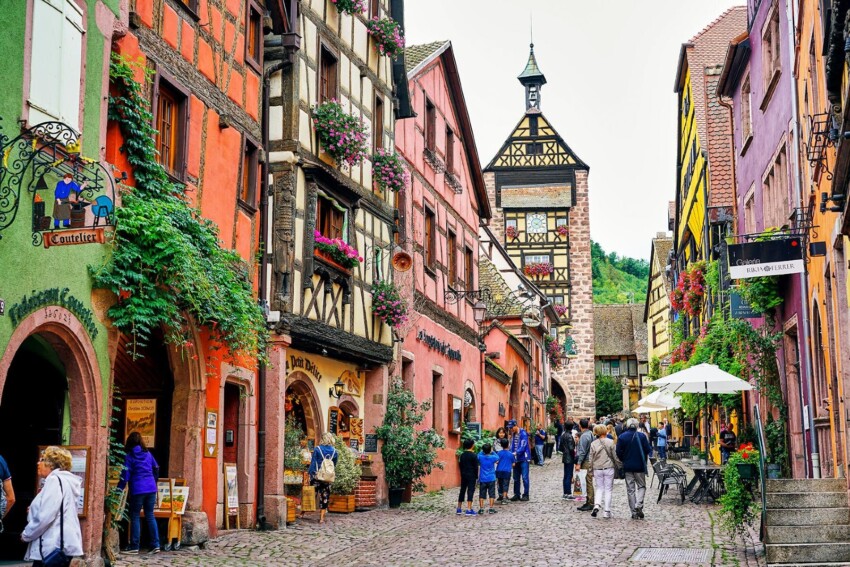
In spite of its inevitably touristic vocation, Riquewihr remains one of the most beautiful and evocative towns on the Wine Route, thanks to its imposing ramparts and tangle of characteristic medieval alleyways.
The best way to discover its most picturesque corners is to wander aimlessly and get lost in the alleys. We recommend that you start your tour of the town at the Dolder, a half-timbered gateway dating back to 1200 surmounted by a beautiful bell tower. Then continue along Rue des Juifs to the Tour des Voleurs, home to a small museum of torture instruments.
For a walk surrounded by lush nature, you can follow the Sentier Viticole des Grands Crus, which will take you to the most prestigious wineries in just 2 km.
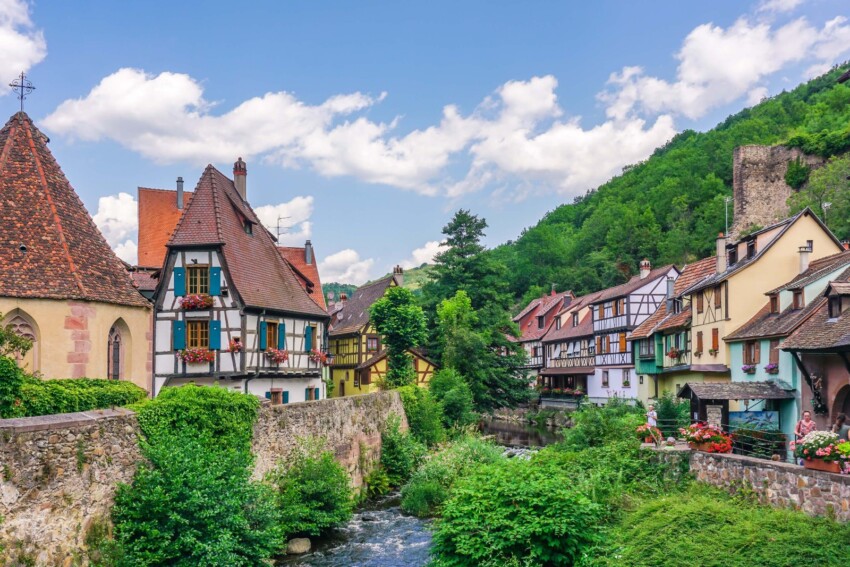
This village is also worth a stop: nestling on the river Weiss, Kaysersberg is a charming little village full of picturesque half-timbered houses and quaint little shops.
Nobel Peace Prize winner Albert Schweitzer was born here and his birthplace has now become a small museum. Fans of the genre can admire glass art at the Verrerie d’Art.
For a bucolic stroll, you’ll be spoilt for choice: there are many fascinating paths, but we recommend the one leading to the ruins of the Chateau de Kaysesberg.
The pretty village of Turckheim is only 7 km from Colmar. Unlike the other Alsatian villages, it is the only village in the region where vineyards grow not only in the hills but also in the mountains.
Admire the Porte de France, a medieval tower that belonged to the town wall that protected the town. Once inside the centre, you will be immersed in the typical Alsatian atmosphere: narrow alleys, colourful half-timbered houses, craft shops, fountains and picturesque squares.
Unique is the experience of the Night Watchman’s Tour, a very old tradition that was discontinued with the introduction of electric light. Every day from May to October, starting at 10 p.m., a watchman in period costume wanders the streets of the city, illuminating them with his lantern. During the walk, he makes the silent streets resound with the singing of local songs in the Alsatian dialect: once upon a time, this was a sort of blessing for all the inhabitants of the town and for the wine-growing lands.
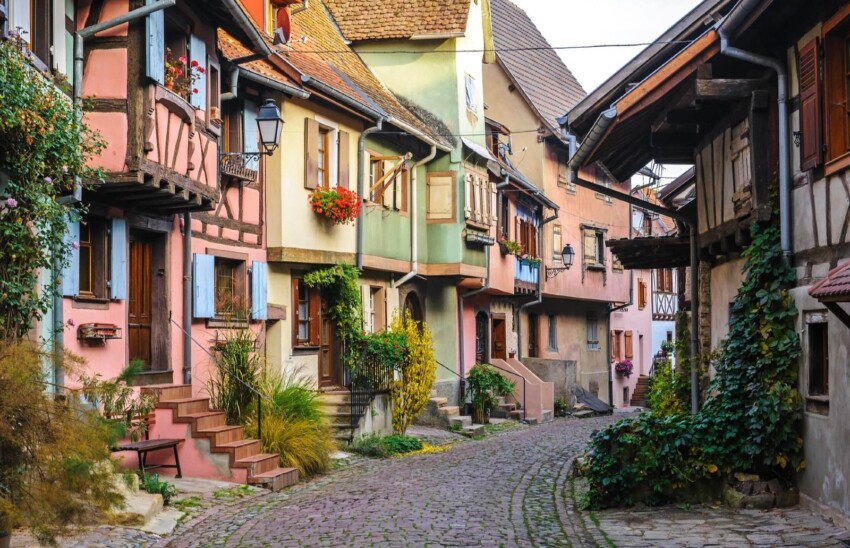
Winner of the prestigious title of Plus beaux villages de France, Eguisheim is a charming Alsatian village with a concentric layout, surrounded by medieval walls. Picturesque and charming, this ancient village is also famous for its wine production, among the best in Alsace.
In fact, as in Turckheim, Eguisheim hosts a famous and popular annual Wine Festival, the oldest in the Alsatian region: in the town there are many caves, wine cellars where you can taste and buy the region’s renowned wines.
Thann, the southern gateway to the Alsace Wine Route, enjoys a centuries-old winegrowing tradition thanks to the famous Rangen vineyard, classified as a Grand Cru in its own right.
The historic centre extends mainly around the Collegiate Church of Saint Thiébaut, one of the most representative examples of Rhineland Gothic architecture in Alsace.
Wandering aimlessly through the alleys and narrow streets, the town reveals its historical wealth: 16th-century houses, fountains, bay windows, towers and fortifications from the 14th and 15th centuries, the banks of the Thur. In a 20-minute walk, you can reach the ruins of Engelbourg Castle and enjoy a breathtaking view of the Rangen vineyards and the Alsace plain.
In the following map you can see the location of the main places of interest mentioned in this article.
